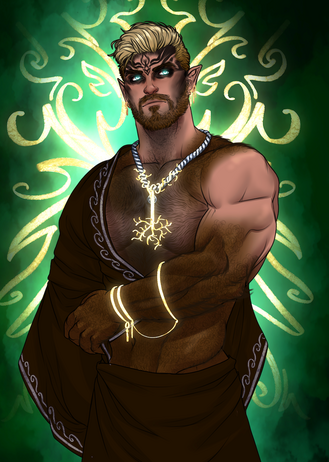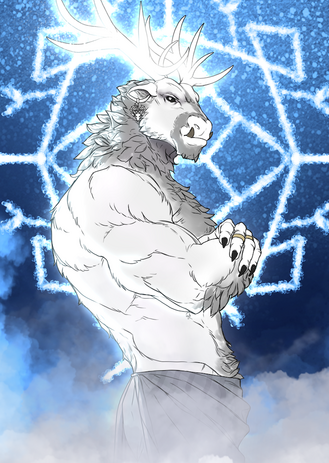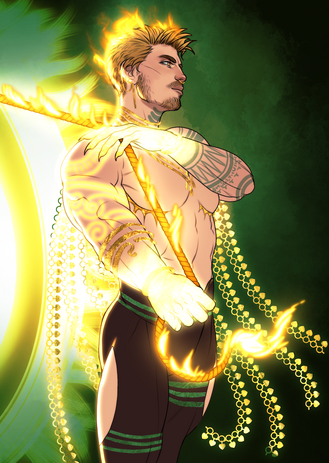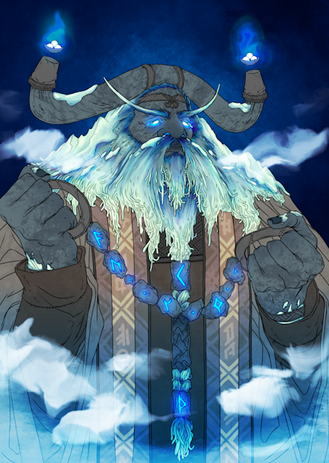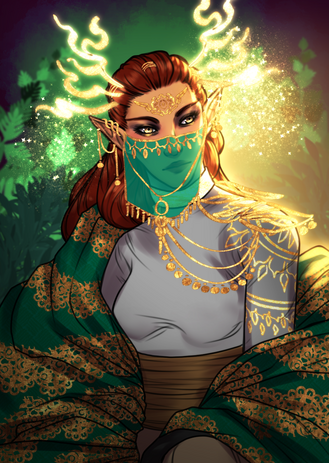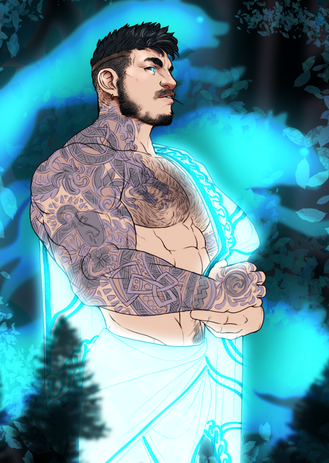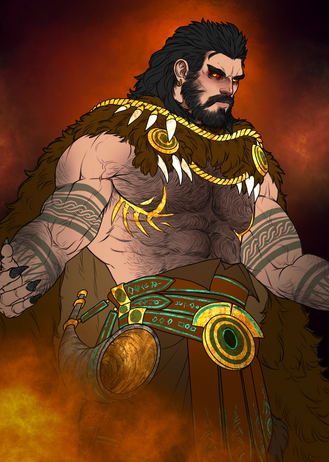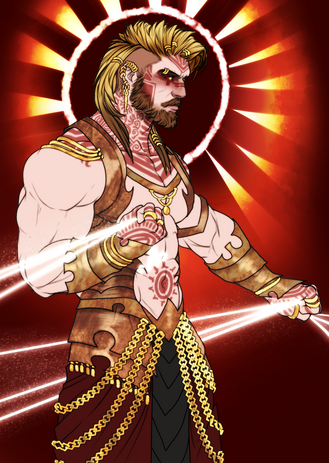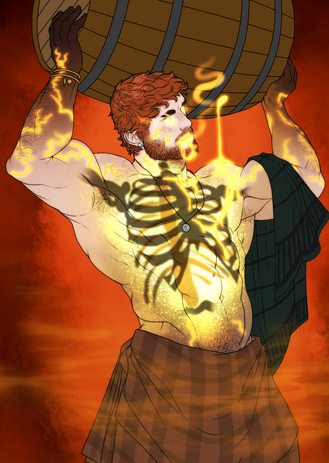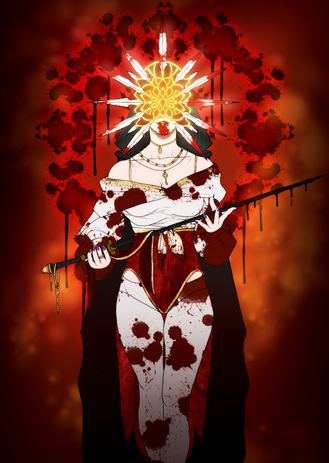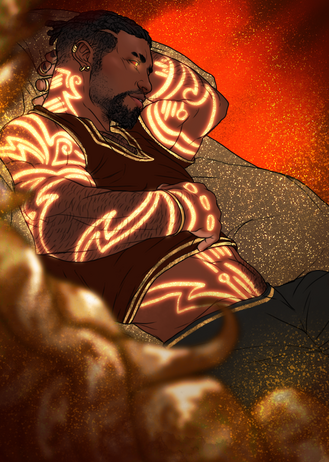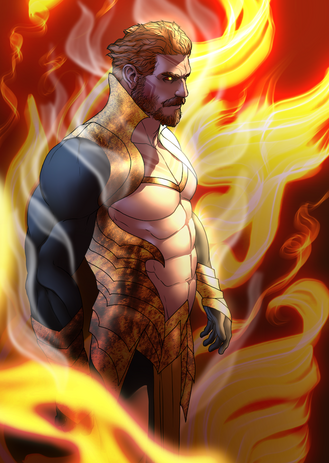Fornoss
| Fornoss | |
|---|---|
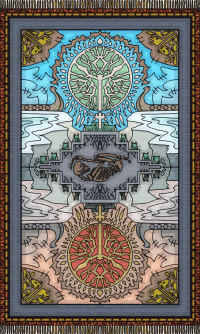 | |
| Religion | |
| Pronunciation | For-noss (like Nosferatu) (clear pause between the two). |
| Origins | Presumed roughly 15,000 years ago. |
| Deities | |
| Two distinct Pantheons of 6 Gods each. | |
Fornoss is one of the earliest Religions of the Ailor Race, that survived thousands of years of conversion by other Religions as well as attempts to be eradicated by various nations, proving exceptionally resillient. The Fornoss faith has a large following, particularly among Velheim and Gallovian Ailor, though a large number of Urlan, Dwarves, and some Ashaven Eronidas also follow it, meaning it is not limited in scope to just Ailor. Fornoss is sometimes also called the Old Gods Religion, but this is not a historically correct term. The Gods are not old from a purely chronological perspective, and it is certainly not the oldest Religion in Aloria. This term was mostly popularized by the Ailor, who when reviewing only their own history, can see Fornoss as the oldest Religion, but when taking the totality of the world's history, Fornoss is a more accurate term, which roughly translates to "Ancient us", an homage to its survival through the ages.
Origins
The birthing of the Gods and the founding of the Religion are two distinct periods. The birthing of the Gods is a mysterious period perhaps thousands of years before the first followers professed their belief in the Gods, as it is said that the Gods wandered for many ages before finding the people that would recognize their worth. The Fornoss Religion is roughly 15,000 years old, though this has an error margin of about 3,000 years, because the proto-Velheim people who were the first Fornoss followers did not have a form of writing at the time. The Religion was founded on a series of islands and part of the mainland of Oldt Tera (Ceardia), where the locals embraced a form of polytheism while most other Ceardian tribes were monotheistic. The Eili offered the faithful escape from the endless bloodshed and Oblation Magic raids under the Elves that terrorized the Oldt Tera shores, fleeing the mainland, and retreating to some island called Aldra, which cannot be found on any modern map. On Aldra however, the Fornoss believers still were not safe, so the Eili contacted the Vola, and created The Pact, which joined both Pantheons to the Fornoss believers and the Fornoss people were finally given safety by combining Eili and Vola Magic through the Taig Gates that allowed them to transport themselves over long distances and colonize distant lands. For thousands of years, the Fornoss followers spread across the world through the Vaarda Gates, until Svartskra. In the modern era, Fornoss remains a very large religion, even if swathes of its followers have converted to other Religions, mostly Unionism.
Core Beliefs
Central Message
The central message of the Fornoss faith is that the faithful are born as creations of the Dragons who in turn were blessed by Árn who is a metaphorical representation of the world, a giant tree of life to symbolize all living things, but that they live as children of the elemental Gods. The Eili Gods were the Gods that were chosen who gave the Fornoss faithful progress, while the Vola Gods were the Gods that were forced onto the faithful but gave them power. The living struggle against each other and outside elements while gaining Soldi or Svaldi, currencies of honor, until their death where these currencies are weighed to determine which pantheon their soul belongs to, before they pass into the afterlife.
Soldi and Svaldi
Soldi and Svaldi are honor currencies that are mostly spiritual, that the faithful gather throughout their life. Small and large actions can increase these individual currencies, but they can also be catastrophically lost or monumentally returned through great events. When a person dies, each of these currencies is weighed and if they reach a certain threshold of either Soldi or Svaldi, they are permitted into the afterlives of the Eili or Vola respectively. A rare occurrence happens when both values are roughly the same, in which both pantheons battle over ownership of a soul, producing a Godsrot Undead while they wait for final judgement. Each God represents a means to gain or lose Soldi or Svaldi, and this currency is mostly decided upon by players to define how pious their character is, but outlined below in short detail:
- Soldi: is gained in the name of Bard by being brave and just, and lost while being inactive to injustice. It is gained in the name of Taig by respecting and putting to rest the dead, and lost by being seduced by Demons. It is gained in the name of Leif by showing passion and loyalty to one's lovers, and lost by committing treason. It is gained in the name of Dáuw by protecting others and crafting things, and lost by letting society slip into anarchy. It is gained in the name of Eirny by defending the faithful from having their culture and stories erased either by sword or writing them down, and lost by destroying or hiding knowledge. It is gained in the name of Halfvel by protecting the environment and lost by needlessly killing animals.
- Svaldi: is gained in the name of Helskorn establishing control over others, and lost from being disavowed by others. It is gained in the name of Thirun by achieving great feats or accomplishments or fame, and lost by losing Duels. It is gained in the name of Aedán by dedicating feasts and parties to others and making art, and lost by destroying cultural heritage of anyone. It is gained in the name of Blodrúna by ending a worthy life and writing good poetry, and lost by ending a weak life. It is gained in the name of Taran by making one's self or others beautiful, and lost by neglecting one's own body. It is gained in the name of Uvan by defeating others in martial combat and succeeding in revenge, and lost by showing cowardice.
Soldi and Svaldi can also be transferred or fought for in the name of others. It is for example possible, that if a person died with low Svaldi and Soldi and thus denied access to any afterlife, that their child might begin a quest to restore the honor of their parent, thus allowing them to move from the world in between (essentially being a Spirit/Undead) to an actual Afterlife. The Gods are merciless with violations of their virtues and sins, but graceful with the time one has to recover from such mistakes. Halfvel always brings warnings of the Black Book fate spun by Eirny before such a person would die.
The Afterlife
The Fornoss faith is somewhat unique in that it has 3 distinct afterlives. Each pantheon has its own separate afterlife with different rules and functions, and then there is to so-called land in between which is a cursed land for souls deemed unworthy. The land in between is an endless gray land without emotion and feeling. Souls wander there until their descendants or friends save their honor, or until their name is forgotten and they die one final time. The afterlife for the Eili is called Eiliheim, which is thought to be a perfect garden of forever spring and tranquility, where beautiful music and animals grace the skies and eternal peace is felt. The afterlife for the Vola is called Volaheim, which is thought to be a heat-scorched mountain land of forever summer and humidity, where the earthly delights and pleasures are tingled with endless hedonistic satisfaction. A dying soul can never arrive in both, so most faithful tend to choose which one they would rather reach, and plan their Soldi/Svaldi gain appropriately.
Svartskra
Svartskra is an important event in Fornoss history, because it changed how the Gods interacted with mortals and even changed the pantheons themselves. The event itself is historically different to date, because both pantheons are cagey about revealing too much information about it out of self-interest. The faithful are aware that both pantheons tell versions of lies to their believers to make themselves appear to be the most righteous in this divine conflict. Svartskra occurred sometime after the large colonization boom that was allowed by the portals created by Taig that traversed long distances by partially traveling through Volaheim. There is a general agreement among scholars that the event was caused by a sense of betrayal by the Eili, who felt the Vola had doublecrossed them and taken too much spiritual control over the faithful. Svartskra itself took at least a century to complete, seeing several phases:
- The re-arrangement phase: During this phase, the pantheons themselves were re-arranged due to the internal strife. The Eili Gods Jord of the metallic silence and Gro of the flesh amalgam were expelled from the faith by Bard for having gotten them all in this mess, since they were the ones to broker the agreement with the Vola. Elsewhere, Helskorn banished the Vola Gods Flaed of the raging oceans and Aestas the autumn rot for having failed to keep the peace on their end. Both of these pairs of Gods and Goddesses disappeared from the pantheons and much of their lore and knowledge was lost to time, only fragments remaining.
- The betrayal phase: During this phase some decades later, one god of each pantheon switched sides but was forced to do so by their own faithful rather than Bard or Helskorn. Aedán was expelled by the Eili worshipers from the Eili pantheon because of his neglect of his divine duty. Instead of helping the faithful through times of cultural upheaval, he just partied all day long, and so he was welcomed among the Vola. Eirny in turn was expelled by the Vola worshipers from the Vola pantheon because she refused the wroth and spite inflicted on the Eili Gods by the other Vola Gods. She wishes to spend her time recording the fates she was given authority to, and thus was welcomed among the Eili for her erudite dedication. At the tail end of this, Taig shut all the Volaheim gates, thus inadvertently cutting all Fornoss faithful lands off from instantaneous transportation access, which caused many cultures to fracture.
- The silent phase: During this phase, the final conclusion of Svartskra took place nearly a hundred years after it started. The Eili and Vola, after a period that could best be described as a war in heaven, agreed to a formative truce that would make them stop fighting, which resulted in casualties among the mortals mostly. The agreement that was settled, was that the faithful lands would be divided and their power limited to where their name was invoked more. If a certain area had a strong Eili patronage among the faithful, the Eili would hold power there, and if the Vola were invoked often they would hold power there instead. The other pantheon was denied spiritual power in the areas they were praised less, and so the world was essentially divided and the war ended.
The silent phase however had yet another unintended side effect, the boundary of authority continued to shift. The Vola would undermine Eili power by subtly causing calamity to strike an area which would cause the locals to invoke their name more in fear or in the hopes of being given more power. The Eili in turn had eventual control over any area, because peace and prosperity from the calm of their truce would eventually lead to Eili worship overtaking Vola worship which increased in hard times. Both pantheons tried to outsmart each other, but ensured a secret war would start where they tried to contest each other's authority through underhanded means. Whatever the situation, both pantheons are desperate not to start an all-out war between them again, and so their refusal to directly interface with one another causes problems to the faithful, especially when they need them to work together but neither side does anything to help.
Gods and Goddesses
Fornoss has a unique pantheon construction in that it has two separate and often conflicting pantheons. The Eili pantheon Gods (in blue and green) are generally seen as morally righteous but deceitful and mindful. The Vola pantheon Gods (in red and orange) are typically seen as cruel and violent but honest and powerful. Followers may choose specific Gods as their patrons or worship all equally. It is also possible to worship either Eili or Vola more than the other, or outright refuse to worship a specific pantheon. Still, generally, a believer can't get the whole core of Fornoss without acknowledging both pantheons and worshiping both.
- Bard is the god of justice and leader of the Eili pantheon. As god of justice he is responsible for the strong sense of fairness and the rule of law among the faithful, but he also acts as divine judge for those who have transgressed and puts curses on those who require punishment. Bard together with Helskorn is responsible for the Svartskra, demanding the Eili and Vola Gods disavow each other, and refrain from interacting. He is prayed to, to wish for justice in troubled times, and for clarity to those in power.
- Taig is the god of life and death and the demon-ward Eili. As god of the afterlife, he holds up the mirror to the other dimensions and guides the burial rites of the dead. When summer comes heralding the burial of the dead in thawing helbolwen he becomes a formless levitating robe with frozen hands to show the mirror. When winter comes heralding the torment of Demons he becomes an Urlan and protects the faithful from their wicked machinations, while the dead lie embalmed waiting for the next summer to be buried.
- Leif is the God of love and change. He teaches the faithful to be kind and affectionate, to show passion to one's loved ones and care for those in need. He is often seen as the patron of parents and caretakers, and depicted with blazing chains as he drags the sun through the sky with the moon following in tow, tied to the sun by a chain of stars. Leif is prayed to for goodwill from others and kindness in one's own heart. He is also conventionally seen as the God of fire and symbolized by this primal element.
- Dáuw is the God of crafts and protection and the mountains. An earth-element God in symbolism, he represents the wealth and strength of the mountains and the ground. He teaches the faithful metal forging and casting, the perfection of gem cutting and the art of trade and commerce. But he also represents the sturdiness of armor and the protection of shields, defending the faithful in their time of need. He is prayed to both for protection from attacks from others, and wealth and fortune in work.
- Eirny is the Goddess of fate and sagas. She blessed the faithful with the Rune-script they still use, and weaves the stories of their lives in written runes on tomes. Also considered a Goddess of literature and record keeping, it is in her name that libraries and scriptoriums are blessed. Eirny appears as a Skyborn Elf bringing with her curiosity to the world, and to see stories unfold. And for those with low Svaldi or Soldi, she writes Black Tomes to predict their cursed fate if they do not change.
- Halvfel is the God of beasts, the hunt and his demigod offspring. Halfvel is prayed to for protection from the wilds and unknown beasts and monsters, while he also offers guidance while disguised as a beggar to teach the faithful humility and warn them of Eirny's Black Tomes so they can avert their doom. He is also the only god who intentionally lays with mortals, giving birth to the Halfvel Godborn who call him the Wolf-Father as they are born self-controlling Marken (werewolves) in service of the faith.
- Helskorn is the God of power and leader of the Vola pantheon. As god of domination and legacy, he is responsible for the very rebellious and unruly nature of the faithful to being repressed by outside forces, giving them a strong sense of freedom, free will, and desire to be famous or known before time gets the better of them. Helskorn together with Bard is responsible for the Svartskra, demanding the Vola no longer bless the Eili with their aid. He is prayed to for the satiating of lust for power and glory.
- Thirun is the God of Magic and vanity from the perfection of skill. It is he who the faithful believe to be the source of all Magic, which to the faithful is both a personal blessing but also a grave burden that tests the mental fortitude of the mind. Thirun preaches that Magic is a touch of divinity close to Godhood, but that it equally bears a curse on the mind that can quickly reduce a disciplined individual to a loathsome and indolent sloth. He is prayed to for greater Magical power and insight.
- Aedán is the God of culture, art, and party. Aedán was once an Eili and Bard's husband, but now spends his days and nights drinking and partying with little to no regard to his divine duties. Aedán is capable of producing the most soul-crushing beautiful art and he inspires and teaches musicians the many instruments and musics of their people. It is said from all the drunken stupors and denial of his godly duty, he is becoming something monstrous that is growing within him, and that he is cursed knowing the future.
- Blodrúna is the Goddess of poetry and carnage, and this makes her a complicated individual. She inspires both the skill of speech and wit of tongue to the Fornoss bards and skalds, but also signifies the weight of blood in the literal and figurative. She is the beauty of carnage and killing, the elegance of death, and rune-reading from splatters of blood. She demands the weight of blood-feuds and blood-pacts among the faithful, and is the reason why most warriors in Fornoss seek a poetic death bathed in blood.
- Taran is the God of beauty and time. He is known in the faith as a Hamr which means a shapeshifter who can change any part of their body. He represents the beauty of the living form, of the bodies of mortals and of the art of body sculpting. This can include tattoos, physical training, accessorizing, but also magical manifestations. Taran is prayed to for everlasting beauty and to be desired by others, while his favored often run make-over shops to draw out the designed grace and beauty in their clients.
- Uvan: is the God of war and combat. He is the glorious fury that has challenged many Gods to duels and never been defeated. When war begins, the faithful invoke his name to be blessed with strength on the battlefield, and fury in negotiations. In the arena, warriors pray to him for victory, and those who are wounded pray to him to be given the strength to survive and see to vengeance for their disgrace. Uvan is the twin-brother of Thirun, the both of them representing the opposites of Magic and Martial.
Priestly Activities
Fornoss does not have a formal priesthood associated with it, because it is a very disorganized religion. What this means, is that each valley, each fjord, each town, and each city, may have slightly altered folklore. Each priest may tell the legends and folktales of the Gods slightly differently, and some places far removed from society may even use different names altogether. The lore presented on the God listing should generally remain consistent, but players are encouraged to embellish details and fill the gaps with their own unique spin, and generally speaking, even if it contradicts the views of other Characters, that is just regional variance. While there is no strict hierarchy under a Fornoss version of the Pope, Fornoss does have official religious figures with occupations within wider Fornoss believer societies.
General Priesthood
There is no formal priesthood in Fornoss worship, any person can at any point in time proclaim themselves a priest, and some people do so even just for their own sake. Unlike Unionism, Fornoss priests are not concerned with expanding the flock of believers, they just want to live right by the Gods and help other faithful on that journey also. It is very common for priests to also double as other religious occupations like Helvigja or as Knights or even Nobles. Priesthood in Fornoss does not impede on anything, because there are no requirements. However, it is common practice for anyone who does want to become a priest, to at least seek out a mentor to learn the basics of what Priests usually do, or say, in certain situations. it's entirely possible to be a self-taught bog-priest, but in more urbanized settings, mentorship is common. Mentors hold a great importance in the lives of priests, who tend to pick carefully.
Helbolwen & Hel
A Helbolwen is not a person but a place, but it bears explaining because the term comes up frequently. A Helbolwen, roughly translated to Hellish Burrow, can best be understood to be a crypt where the Fornoss dead are interred in coffins in the walls, or sometimes when coffins cannot be made simply in holes in the wall as is, the frost keeping them from decaying and slowly mummifying instead. Helbolwen are always built underground or in hills, so that it can expanded by digging further down. Helbolwen always have an entryway which acts both as shrine to Bev, and the actual embalming chamber. Helbolwen when historically built in cold places are only accessible during spring and summer, which are the burial seasons. Autumn and winter become so cold that sections of the Helbolwen freeze over, or become inaccessible. As a result, the dead are embalmed in the embalming chambers, and kept there until the burial season begins and they are interred. The word "Hel", will also come up frequently. It literally refers to Volaheim, as Helskorn's name is "born of Hel" in proto-Velheim, and he calls Volaheim Hel himself. The word has however become a derogatory term used both by Fornoss and non-Fornoss believers to describe something in negative. This is not an insult to the Vola or to Helskorn, if anything he considers it flattery, that his name is invoked in entirely unrelated matters such as "What the Hel is going on here", or "Who in Hel's name are you", both meant to mock who it is being said to, but seen as flattery to Helskorn.
Helvigja
Helvigja, roughly translating to death-consecrator, is one of the peripheral priestly occupations that specifically is a member of Taig's Mortuary Commune. Helvigja primarily perform the mortuary rites, in embalming, interring or otherwise burying the dead. The embalming process is always accompanied with the Song of the Dead, which is sung throughout the process and the interring process by at least one Helvigja or their protectors. Helvigja work does not end with interring however, in general they keep Helbolwen clean of vermin, other unwanted inhabitants, and in rare cases, are tasked to end the un-life of an Undead who has come back from either improper embalming, or by escaping the land in between. Helvigja also linger around Helbolwen to provide mourning help to those bereaved with death of a loved one, either by using Fornoss rituals to summon the visage of the dead, or by singing to the grave together.
Helharjar
Helharjar, roughly translated to Death Warrior, often come paired with the Helvigja and linger around Helbolwen particularly when they are at risk of being attacked or destroyed. Fornoss is the only Religion permitted to bury their dead whole, and their Helbolwen are often filled with gifts for the dead, meaning they are ripe for plundering by grave looters. Helharjar protect not only the Helbolwen itself from looting or desecration, but also the Helvigja themselves, so the embalmers are not the first and last line of defense of such a holy place. Helharjar also assist the Helvigja with carrying coffins if need be, and frequently stand guard if a Helbolwen is in an active warzone to prevent collateral damage. Helharjar are very often partners of Helvigja, or end up becoming partners of them, due to their proximity of work and coordination.
Andlistari
Andlistari, roughly translated to Spirit Artist, are far more nomadic than the other priestly occupations and travel the wider world with pencil and paper. Andlistari are scribes by nature who record history and events, but most importantly of all, do they record the names and achievements of the dead. In Fornoss faith, it is believed that a person can die twice, once in the physical sense, and a second time when their name is last spoken out loud by someone. As people die, memories of the dead pass on, and eventually there will be no one left to recite the names of the dead, this is where the Andlistari comes in, recording all names, and reciting the names of the dead to the moon before sleep. The Andlistari also serves a secondary function, in that they can make assessments of Soldi or Svaldi of the dead, and help indicate the bereaved if they should quest to restore honor.
Sagnaflétta
Sagnaflétta, rougly translated to Weaver of Stories, are much like Andlistari travelers though it should be said there will be more than enough work for one in Regalia never to travel. Sagnaflétta are scribes just like Andlistari, but focus more on the realm of the Gods than Mortals. Sagnaflétta travel to record oral legends and folklore from the disparate Fornoss faithful across the world, and compile them in a grand book of legends and short rhyming stories. Then, they travel to where the Fornoss faithful live in large numbers, and host gatherings where they read from the book to discuss the lives of the Gods, the inner conflict and interactions they have with one another, and some of the legendary feats the Gods perform. It is highly encouraged to make up legendary actions and interactions of the Gods by players, where that fits within their themes and design.
Expanded Lore
The Expanded Lore section contains additional contextual information about the Fornoss faith. This section is not necessary to read to get a good understanding of the lore, just the background information.
The Arken Matter
One as of yet undiscussed matter, is the status of Arken among the Gods. The wider world has a scientific understanding of the Arken as some kind of advanced Spirit from a different Dimension, but to the Fornoss, they are Gods, but also not actually. There are five distinct Arken Gods in the pantheons: Bard (who is Justice), Eirny (who is Scripter), Helskorn (who is Power), Thirun (who is Pride), Taran (who is Body), and Uvan (who is Fury). These Gods share consciousness with the Demon entities known as Arken, but they are distinct entities from these Arken. When one meets an Arken, that Arken has a shared awareness with the God, but they do not act the same and are not responsible for each other's actions. This is called a Refraction, when an entity has a single awareness, but multiple different bodies which all act independently, just with shared knowledge. Thus, in actuality, while there is a relation to the Arken, the Gods are distinct entities, and insisting that these Gods are actually Demons, is offensive to Fornoss believers.
Taig Gates & Keys
Taig Gates are an ongoing concern or delight depending on one's interpretation, to the Fornoss Faithful. What exactly happens when one opens is unclear, and it is even unclear if Helskorn will allow the portals to open from the other side in Volaheim. There exist Gates on all the major continents where Velheim settlers came to be, from Regalia to Oldtera, to all the landmasses of Southwynd, Northbelt, and even Ellador. All these lands were once connected but now shut off, with their Keys dispersed into the winds. The Keys are Artifacts of Fornoss power, usually weapons, each Key made for a specific Taig Gate. There is currently one known Artifact (belonging to the Nordskag Gate) in circulation in Regalia, called Ándlar, though more could arrive in the future as collector items or loot. It is generally accepted, that opening the Taig Gates without the necessary protections, preparations, or considerations, is generally an awful idea. Nobody knows exactly what is behind those Gates, and that entering the afterlife as a living person, is generally a bad thing unless given protection by the Vola or Eili Gods.
Expanded Gods Lore
The Expanded Lore section contains additional contextual information about the Fornoss Gopds that gives a deeper understanding about their dogma. This section is not necessary to read to get a good understanding of the lore, it just adds more flavor.
| ||||||||||
| Accreditation | |||||||||
|---|---|---|---|---|---|---|---|---|---|
|
| ||||||||
